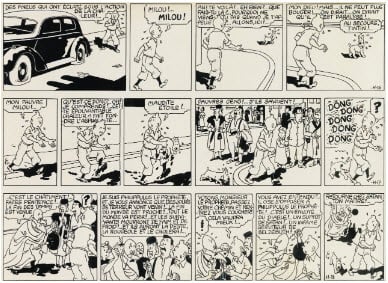Art World
The Ninth Art: Comic Books
French comic books hold a current popularity at auction houses in France and Belgium.

French comic books hold a current popularity at auction houses in France and Belgium.

Sara Langham

Superman, Batman, the X-Men, Wonder Woman, Spiderman, and many other American comic book heroes have leapt from the pages to become animated cartoons, live action television shows, and big-budget blockbusters. While almost everyone is familiar with these names, in France and Belgium the comic book market is also booming, but with different characters filling the pages. They are called bandes dessinées, literally translating to drawn strips and often shortened to BDs. Tintin, Astérix, Gaston, the Smurfs, and Blueberry are just some of the characters that have been celebrated over the last 80 years.
Though sometimes viewed as a childish indulgence, BDs in France are incorporated into the realm of Fine Art. Derived from German philosopher Georg Wilhelm Friedrich Hegel’s Lectures on Aesthetics compiled in 1835, in which major art forms are ranked, BDs have been given the honor of being referred to as the ninth art since the 1960s.1 If recent auction results are any indication, these works are coveted and admired enough to bring in big sale prices at auction. Hand drawn pages and album covers can sell in the hundreds of thousands of dollars for a single page of artwork. Each year, French and Belgian auction houses such as Artcurial, Ader, Piasa, and Tajan hold auctions dedicated only to the sale of BDs.
History:
The style of BDs has its ties to the beginning of art itself. The use of a sequence of images to tell a story is found in cave paintings from nearly 40,000 years ago. The method is also found in a wide array of art forms such as Egyptian hieroglyphs, famous landmarks like Trajan’s column in Rome, religious manuscripts, and paintings. The roots of comic illustration that will be more familiar to the modern reader go back to the early 19th century. Rodolphe Töpffer (Swiss, 1799–1846), an artist and writer, combined his caricatures and sketches into sequences placed within boxes, and published his work as satires. He was the first to employ the word balloon and to include onamonapia, giving action and narrative to his drawings.2
Töpffer’s style gained popularity in the late 19th century, when it was commonplace for satirical drawings to appear in newspapers to mock political leaders or parties. Soon this technique was applied to compilations of illustrations with recurring characters. The culmination came in the 1930s with publications becoming more periodical and popularity gaining.3 The BDs of France and Belgium, comics and graphic novels of the United States, and manga of Japan all flourished after this time, and recently artists have begun to combine the styles and subject matters of all three.
BDs at Auction:
Georges Rémi (Belgian, 1907–1983), the creator of Tintin and better known by his penname Hergé, is one of the most collected BD artists. In a 2012 Sotheby’s Paris sale, a 1941 original drawing from the Tintin series, L’Étoile mystérieuse, sold at Sotheby’s Paris for US$294,062.
Another renowned BD artist, André Franquin (Belgian, 1924–1997), known just as Franquin, had one of his works from Le trombone illustré sell for US$193,888 in a March 2012 Artcurial auction.
While the most successful works are those of the older generation, there is a flourishing community of new artists breaking into the market. Keep an eye out for bandes dessinées sales throughout the year to see more of this fun and dynamic style of art.